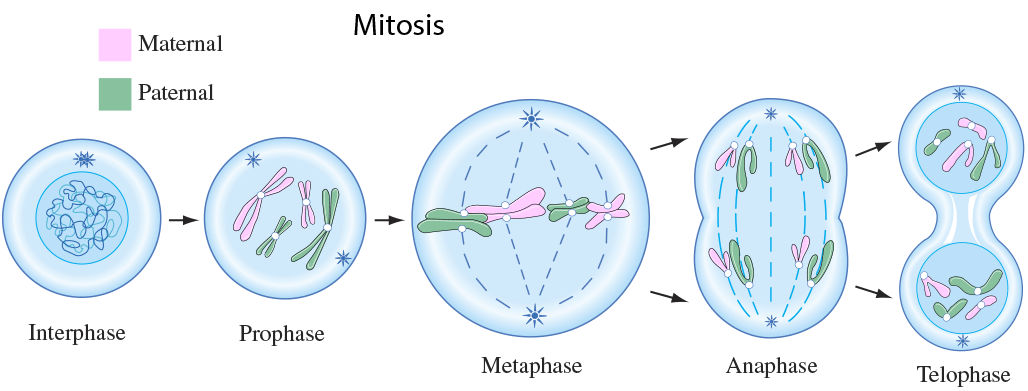list the 4 phases of mitosis in order 😊 four phases of mitosis. diagram of cell division by mitosis. 2019-02-20
Today, we will be discussing an important topic in biology - the process of mitosis. Mitosis is a fundamental process in which a single cell divides into two identical daughter cells. This process is crucial for the growth, development, and repair of organisms. Understanding the different phases of mitosis is crucial for students studying biology.
The Phases of Mitosis:
 As shown in the image above, mitosis can be divided into several distinct phases:
As shown in the image above, mitosis can be divided into several distinct phases:
1. Interphase:
Interphase is the preparatory phase of the cell cycle. During this phase, the cell undergoes growth, DNA replication, and prepares for division. Despite not being a part of mitosis, it is an essential phase for the process.
2. Prophase:
During prophase, the chromosomes thicken and become visible. The nuclear membrane starts to break down, and the centrosomes move towards the poles of the cell, forming spindle fibers.
3. Metaphase:
In metaphase, the chromosomes align themselves at the center of the cell. The spindle fibers attach to the kinetochores, which are protein structures on the centromere of each chromosome. This ensures that the chromosomes will be evenly separated during cell division.
4. Anaphase:
During anaphase, the sister chromatids separate and move towards opposite poles of the cell. This movement is facilitated by the shortening of the spindle fibers.
5. Telophase:
In telophase, the chromosomes reach their respective poles and start to decondense. Nuclear membranes begin to form around each set of chromosomes, preparing for the creation of two new nuclei.
6. Cytokinesis:
Cytokinesis is the final step of cell division, where the cytoplasm divides, and two daughter cells are formed. In animal cells, a cleavage furrow forms and pinches the cell into two parts. In plant cells, a cell plate is formed between the daughter cells, which eventually develops into a cell wall.
Now that you have a better understanding of the phases of mitosis, let’s briefly touch upon the significance of this process. Mitosis plays a vital role in growth and development. It ensures that an organism can grow from a single-celled zygote to a multicellular organism with trillions of cells. Mitosis also helps in the repair of damaged tissues and the replacement of old, worn-out cells.
Another interesting aspect of mitosis is its regulation. The cell cycle is tightly controlled by various checkpoints, ensuring that errors are minimized and the process occurs smoothly. Dysregulation of the cell cycle, leading to uncontrolled cell division, is one of the hallmarks of cancer.
Cells - Science Pal:

Cells can be classified into two main types: prokaryotic and eukaryotic cells. Prokaryotic cells, such as bacteria, lack a true nucleus and other membrane-bound organelles. On the other hand, eukaryotic cells, found in plants, animals, and fungi, have a nucleus and various organelles that help carry out essential cellular processes.
Each type of cell has specific structures and functions that contribute to its overall role in the organism. For example, animal cells have structures called lysosomes, which are responsible for breaking down waste materials. Plant cells, on the other hand, have chloroplasts that enable them to perform photosynthesis and produce energy.
Cells are also capable of reproduction. While mitosis is the process by which somatic cells divide, there is another type of cell division called meiosis. Meiosis occurs in specialized cells called gametes and is involved in sexual reproduction.
Understanding the intricacies of cells is crucial in the field of biology. Scientists are constantly studying cells to uncover their mysteries and further our knowledge of life itself. Through innovative techniques such as microscopy and genetic engineering, we continue to unlock the secrets hidden within cells.
In conclusion, the processes of mitosis and the complexity of cells are elements of biology that intrigue and captivate scientists and students alike. By delving into the phases of mitosis and exploring the intricacies of cells, we gain a greater understanding of life’s fundamental processes. So, keep exploring, keep learning, and let your curiosity lead you to new discoveries in the fascinating world of biology!
If you are looking for 😊 Four phases of mitosis. Diagram of Cell Division by Mitosis. 2019-02-20 you’ve visit to the right web. We have 5 Pics about 😊 Four phases of mitosis. Diagram of Cell Division by Mitosis. 2019-02-20 like This detail description of the phases of mitosis for the students to, Cells - Science Pal and also 😊 Four phases of mitosis. Diagram of Cell Division by Mitosis. 2019-02-20. Here you go:
😊 Four Phases Of Mitosis. Diagram Of Cell Division By Mitosis. 2019-02-20
 momentumclubs.orgphases mitosis four stages diagram cell division mito
momentumclubs.orgphases mitosis four stages diagram cell division mito
Cells - Science Pal

The Process Of Mitosis - IBiology
 paulinesibiology.weebly.commitosis
paulinesibiology.weebly.commitosis
ما هي مراحل الانقسام؟ - أخبار 2022
 ar.weblogographic.comThis Detail Description Of The Phases Of Mitosis For The Students To
ar.weblogographic.comThis Detail Description Of The Phases Of Mitosis For The Students To
 www.pinterest.commitosis phases biology
www.pinterest.commitosis phases biology
The process of mitosis. Mitosis phases biology. Mitosis phases four cytokinesis cell phase each happens cycle describe cells biology ck12